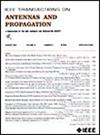Surface-Wave Metaprism for Smart Surface Communications
IF 5.8
1区 计算机科学
Q1 ENGINEERING, ELECTRICAL & ELECTRONIC
引用次数: 0
Abstract
We present a design technique and numerical validation for a surface-wave “metaprism” (MTP) acting as a frequency-dependent anomalous reflector for next-generation communications in a smart radio environment (SRE). This device holds promise for enabling physical layer frequency multiplexing and addressing waves in radio blockages. The proposed MTP is constituted by a passive and nonreconfigurable metasurface (MTS) comprising three sections. The first section (receiver) operates with low dispersion, receiving broadband signals coming from the base transceiver station (BTS) at a predefined angle and converting them into surface waves (SWs). The subsequent transition section gradually increases the dispersion of SW, guiding it toward the highly dispersive transmitter section, which finally converts the SW into space waves (SPWs) radiated toward frequency-dependent angular directions. The latter property motivates the name “MTP.” MTP is implemented by an array of subwavelength metallic patches printed on a grounded dielectric slab, initially modeled using a homogenized penetrable impedance boundary condition (PIBC). The dispersion analysis of the MTS unit cell reveals the impact of patch geometry on dispersion characteristics, which is important for achieving broad scanning performance. Full-wave simulations validate the design, demonstrating high-power conversion efficiency and a reasonable frequency scan range. Moreover, the study compares the performance of SW-based MTP with that of a spatially dispersive reflecting intelligent surface (RIS), highlighting the advantages of MTP. In addition, this article investigates an “around the corner” design, where the SW reroutes the signal around a bent transition section, shading light on the relationship between SW dispersion and power loss due to edge diffraction.用于智能地面通信的表面波元棱镜
我们提出了一种表面波“元棱镜”(MTP)的设计技术和数值验证,该表面波“元棱镜”(MTP)作为智能无线电环境(SRE)中下一代通信的频率相关异常反射器。该设备有望实现物理层频率复用和无线电阻塞中的寻址波。提出的MTP由一个被动的、不可重构的元表面(MTS)组成,其中包括三个部分。第一部分(接收器)以低色散运行,以预定义的角度接收来自基站收发站(BTS)的宽带信号,并将其转换为表面波(sw)。随后的过渡段逐渐增加了SW的色散,将其引导到高色散的发射机部分,最终将SW转换成向频率相关角方向辐射的空间波(spw)。后一个属性激发了“MTP”这个名称。MTP是通过在接地介质板上印刷亚波长金属贴片阵列来实现的,最初使用均匀化可穿透阻抗边界条件(PIBC)建模。通过对MTS单元电池的色散分析,揭示了贴片几何形状对色散特性的影响,这对实现宽扫描性能至关重要。全波仿真验证了该设计,证明了高功率转换效率和合理的频率扫描范围。此外,研究还将基于sw的MTP与空间色散反射智能表面(RIS)的性能进行了比较,突出了MTP的优势。此外,本文还研究了一种“绕过拐角”的设计,在这种设计中,SW绕过弯曲的过渡段重新布线信号,从而掩盖了由于边缘衍射导致的SW色散和功率损失之间的关系。
本文章由计算机程序翻译,如有差异,请以英文原文为准。
求助全文
约1分钟内获得全文
求助全文
来源期刊
CiteScore
10.40
自引率
28.10%
发文量
968
审稿时长
4.7 months
期刊介绍:
IEEE Transactions on Antennas and Propagation includes theoretical and experimental advances in antennas, including design and development, and in the propagation of electromagnetic waves, including scattering, diffraction, and interaction with continuous media; and applications pertaining to antennas and propagation, such as remote sensing, applied optics, and millimeter and submillimeter wave techniques

 求助内容:
求助内容: 应助结果提醒方式:
应助结果提醒方式:


